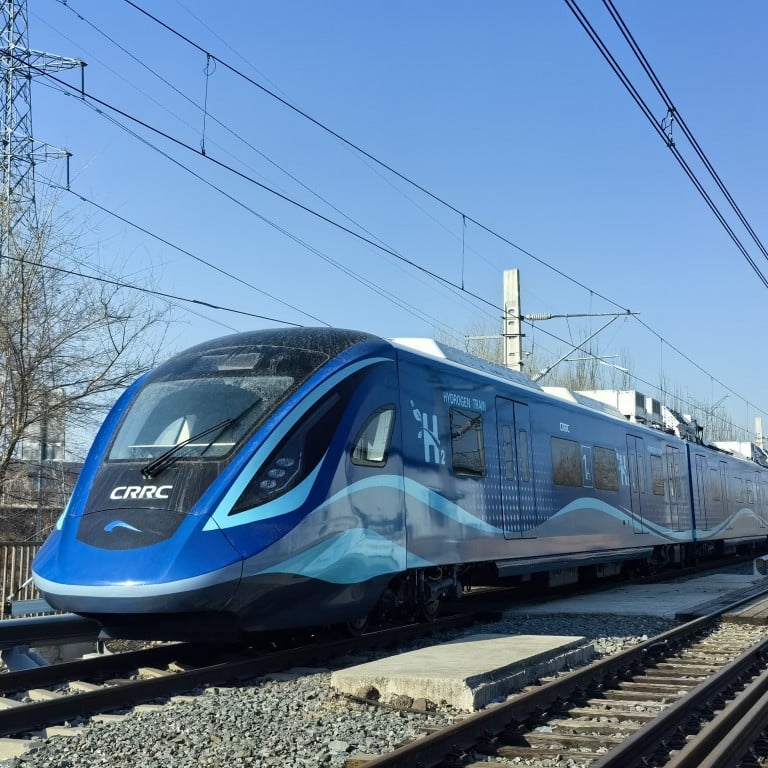
China’s hydrogen ambitions chug on as train trial aims to keep green agenda on track
- Reaching 160km/h (99mph) in a trial run, new hydrogen-powered train is touted as cleaner transport option in nation’s bid to peak emissions by 2030
- But experts say more work needs to be done to cleanly produce hydrogen, with technical and cost impediments standing in the way
China’s first hydrogen-powered passenger train has reportedly hit the normal operating speed of mainstream commuter rail systems – but without any commuters on board.
And there is still a long way to go in its bid to reach speeds attained on the country’s vast high-speed rail lines that keep getting faster.
Nonetheless, state media said the milestone was evidence of the nation’s advancements in green technology and a step toward the commercialisation of cleaner transport options. The progress also comes as the world’s largest carbon emitter cranks up efforts to harness the clean-burning fuel ahead of a self-imposed deadline to peak the nation’s emissions by 2030 while transitioning to a greener, low-carbon economy.
The four-car train was said to have accelerated to 160km/h (99mph) in a trial run on Thursday at a facility of state-owned train maker CRRC in the northeastern city of Changchun, Jilin province. It boasts hydrogen fuel batteries and supercapacitors said to be capable of travelling at least 1,000km.
For context, the high-speed rail line from Beijing to Shanghai stretches 1,318km.
China puts trust in AI to maintain largest high-speed rail network on Earth
Xinhua quoted a technician with the CRRC’s national train technology centre as saying that the train’s powertrain, aerodynamics, brakes and safety systems were all being put to the test.
Beijing’s ambitious undertaking to gradually reduce emissions, with an eye toward carbon neutrality by 2060, was pledged by President Xi Jinping in a 2020 address to the United Nations. But the goal has raised concerns about curtailing China’s carbon-intensive manufacturing and service sectors, leading to greater emphasis being placed on renewable energy developments.
China, already in the vanguard of the global green transition, sees hydrogen as one of the new vehicles for nurturing nascent technologies and industries, on top of advancements in solar power, wind farms, electric vehicles, lithium batteries and the electrification of transport. China is already the world’s largest hydrogen producer on the strength of its chemical industry and oil-refining capacity.
China released its first national-level hydrogen development plan in 2022, envisioning the wider use of hydrogen trains, cars, trucks and ships, as well as 100,000 to 200,000 tonnes of “green hydrogen” produced annually by 2025 using electricity from renewable resources.
The National Energy Administration also spotlighted hydrogen innovation, demonstrations, green production and the expansion of application scenarios in its 2024 work plan released on Monday.
To that end, the CRRC has said that hydrogen-powered commuter trains running 500km per day could reduce carbon dioxide emissions by more than 10,000kg a year.
How China built the world’s largest bullet train network
But new projects in the pipeline have raised concerns of overcapacity, as commercial demand has yet to be catalysed, and there are existing barriers.
“Storage and transport of hydrogen are costly and not absolutely safe,” said Wang Dandong, a doctorate researcher in chemistry with Zhejiang University. “Most hydrogen made in China is filthy, using fossil fuels such as coal, and there are technical and cost issues involved in producing the gas by using renewable energy.”
Still, Beijing is seen making headway. Lauri Myllyvirta, lead analyst at the non-profit Centre for Research on Energy and Clean Air, said in a November report that China’s carbon dioxide emissions were set to fall in 2024, and that the reduction could be structural and sustained, thanks to its record growth in the installation of new low-carbon energy sources.
“China’s emissions rebounded in 2023, but it was also accompanied by record installations of low-carbon electricity-generating capacity, particularly wind and solar,” Myllyvirta said. “Hydro generation is set to rebound from record lows due to drought in 2022-23.”

